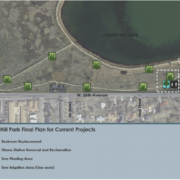Mountain Area Land Trust adds Gilpin County
By Steve Knapp
If the Mountain Area Land Trust recently decided to extend its energies and expertise into Gilpin County, it’s because Gilpin’s wealth of ecological and historic gifts make it a natural choice. Conserving mountain-area jewels since 1992 across 3,096 square miles of Clear Creek, Jefferson and Park Counties, MALT has more than 20,000 acres of pristine forests, sylvan meadows and timeless views already to its credit. As it happened, the hard-working nonprofit’s standing invitation to Gilpin County landowners was inspired by Gilpin County landowners.
‘We were receiving phone calls from people in Gilpin asking who they should contact about getting conservation easements,” says MALT director Jeanne Beaudry. “We found out that a lot of Gilpin County was very rural. The Clear Creek Land Conservancy works in Gilpin, but its main focus is on the Clear Creek watershed. There’s a statewide land trust that could do it, but there was no local trust that serviced Gilpin County.”
“We were receiving phone calls from people in Gilpin asking who they should contact about getting conservation easements,” says MALT director Jeanne Beaudry. “We found out that a lot of Gilpin County was very rural. The Clear Creek Land Conservancy works in Gilpin, but its main focus is on the Clear Creek watershed. There’s a statewide land trust that could do it, but there was no local trust that serviced Gilpin County.”
With more than half of Gilpin’s 98,500 acres bound up in Golden Gate Canyon State Park to the east, and the Arapaho and Roosevelt National Forests to the west, MALT’s focus will be on the broad central corridor along State Highway 119. Its first job will be simply to let the good citizens of Gilpin County know that MALT is at their service.
‘We want to let them know how trusts can help preserve the wild character of their communities, and preserve their scenic vistas, open space and wildlife habitats,” Beaudry says. “We’re here to answer their questions, listen to their ideas, and help them set up conservation easements.” While most folks will look favorably on a legal instrument that helps to preserve a unique and treasured quality of life for generations to come, not everybody understands exactly how that instrument works, or how MALT is able to craft conservation easements that suit individual wishes and goals. Explaining the natural, cultural and financial benefits of private land conservation is all in a day’s work for MALT’s land conservation specialist, Matt Ashley. “An easement is really a very flexible mechanism,” Ashley says. “One of the neater things about them is that they can be customized to fit each landowner’s specific needs.”
MALT’s core values emphasize protecting scenic views and wildlife habitat, preserving recreational opportunities and traditional land uses like ranching, and providing links between other open space areas. But MALT can just as easily help landowners craft easements to protect places of historical significance, relieve tax burdens, create buffer zones against development, or ensure water quality factors.
“There’s a common misconception that conservation easements have to allow public access, and that’s not the case,” Ashley says. “Each easement is an agreement a landowner reaches with us, and the landowner can put all kinds of stuff into it. They don’t have to allow public access if they don’t want to.”
Whichever better angel it is that motivates a property owner to seek a conservation easement, and whatever form that easement may take, Gilpin County residents can be certain that a call to the Mountain Area Land Trust is the best first step toward making a tangible impact on their cherished mountain fastness that will inspire and delight long into the future.
“We’re really excited to welcome Gilpin County into our service area,” Beaudry says. “It just makes sense for everybody.”
To learn more, call 303-679-0950, or visit planjeffco.org.


 capable of taking over property. It seems to prefer moist areas, while Dalmatian toadflax is doing just fine, thank you, on drier foothills slopes. According to Colorado State University, the two together occupy about 75,000 acres in Colorado, and “Toadflax invasion is favored by disturbance and they invade degraded areas such as roadsides, abandoned lots and fields, gravel pits, clearings, and overgrazed rangeland. In Colorado, these weed species are found at elevations from 5,000 feet to over 10,000 feet.” [
capable of taking over property. It seems to prefer moist areas, while Dalmatian toadflax is doing just fine, thank you, on drier foothills slopes. According to Colorado State University, the two together occupy about 75,000 acres in Colorado, and “Toadflax invasion is favored by disturbance and they invade degraded areas such as roadsides, abandoned lots and fields, gravel pits, clearings, and overgrazed rangeland. In Colorado, these weed species are found at elevations from 5,000 feet to over 10,000 feet.” [


